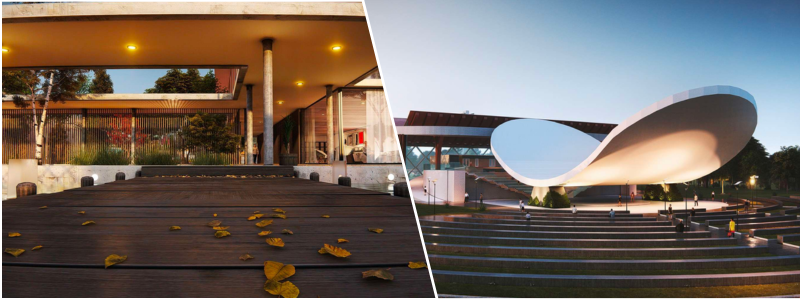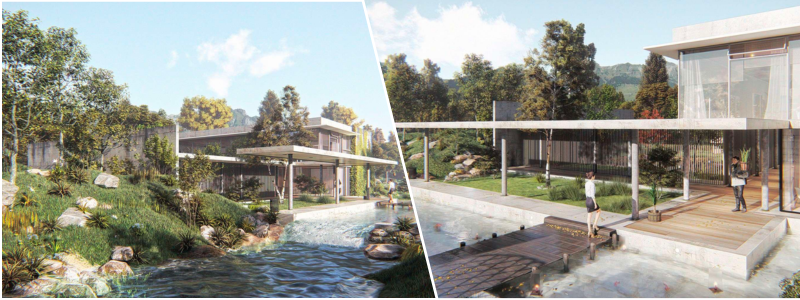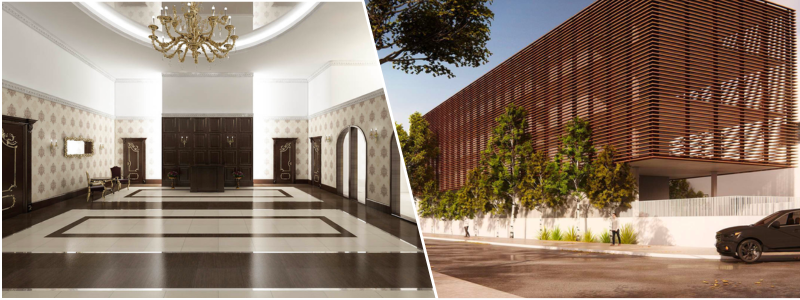When someone mentions “metaverse,” the first thing to cross your mind is probably Facebook, which has now changed its name into Meta and expanded its business model from social media to virtual reality. An important distinction has to be made between Meta (the company) and Metaverse (the ecosystem) because they are different things. Meta is a platform where users and advertisers can utilize Metaverse to interact with each other. However, the Metaverse refers to the AR/VR ecosystem itself and is not a property of Meta. Think of the Metaverse as the Internet; everybody can use it, yet nobody owns it.
The Metaverse is a digital ecosystem with all the features necessary to allow individuals, businesses, organizations, and society to interact and communicate. One of the most common examples is how a user can build a virtual office or storefront to conduct day-to-day business operations within the Metaverse. It is a virtual world in every sense of the word, almost like the matrix.
While Metaverse has been around for about two decades, it remains in an early stage of development. Getting into the Metaverse is not that difficult; get yourself a VR headset, and you’re ready to go. But similar to the physical world, developments mean creating infrastructure inside the virtual atmosphere; otherwise, it is an empty space, and that’s where architectural designs come in.
Metaverse Architectural Design services
An architectural firm typically comprises an architect to design a building, engineers to calculate structural feasibility, builders to physically handle the construction, and administrative employees to handle paperwork. A metaverse architectural firm replaces the engineers and builders with 3D modeling design services and developers. The design services from both firms are pretty much the same, such as building construction, renovations, exterior designs, 3D interior design services, urban planning and design services, real estate developments, and design consultations. A big difference is that the metaverse type produces virtual buildings instead of physical ones.
The jobs of metaverse architects revolve around designing and constructing virtual structures and landscapes in a virtual environment. Unlike mere digital models, the infrastructures must be integrated into the metaverse ecosystem so users can navigate and interact with them. Designing such an infrastructure is like creating an immersive VR-based architectural walkthrough at a much larger scale. Therefore, a metaverse architect must know building design, engineering, computer science, and game creation.
Best examples
Metaverse is a transformational platform that may redefine the nature of collaboration between people and machines. Combining immersive visualization technology and cloud computing enables anybody to run and manage businesses outside the constraint of physical spaces without losing efficiency. Metaverse is also an effective simulation tool to test ideas, manufacturing processes, and products to gauge their technical viability before real-world implementation.
The best example (thus far) of architectural design services is the creation of a digital twin, where companies build a fully functional digital copy of their manufacturing facilities for production simulation. BMW is among the first to have a metaverse-based factory built in collaboration with Nvidia. The virtual factory comes equipped with everything its real-world counterpart has and is primarily utilized to measure its manufacturing robots’ abilities to perform complex tasks.

Process simulation is nothing new in product designs, such as computational fluid dynamics and wind tunnels. However, Metaverse architecture design services take it to another level thanks to real-time digital modeling and immersive experiences. It turns out that digital twin is not limited to the manufacturing and design industry. Singapore has begun a massive undertaking to build a digital twin of its urban landscape and topographical data. Shanghai and Las Vegas have embarked on the same venture, too. All those metaverse twins are used as digital simulation tools to test large-scale urban planning projects.
A digital twin is reverse engineering done for the virtual world. Metaverse architects build a virtual version of a building, structure, or even an entire city based on actual data from the physical objects. As far as project planning is concerned, the simulation eventually becomes a virtual prototyping process. It allows people to conduct experiments, recognize anomalies, and prevent safety issues.
RELATED: Learn About Architectural Design Fee Schedules, Rates, and Pricing for Architect Firms’ Costs
Virtual architectures
Of course, creating a digital twin of a city or a factory is a massive project likely undertaken only by a select few. Most metaverse users will be interested in creating a much simpler virtual structure like houses, offices, stores, amusement parks, sheds, barns, garages, bridges, roadside attractions, or anything they usually encounter during daily activities in the real world.
When simulation is not in the equation, the metaverse architects can create just about any structure in a relatively short period. One of the main reasons is the lack of engineering problems. Since the primary concern is visuals, the architect spends less time (if at all) checking structural integrity, calculating and purchasing construction materials, obtaining permits, weatherproofing, wiring, and plumbing. Visualization is all that matters, whereas functionality and comfort come far behind.
Exterior design makes up for the bulk of the work. When someone wants to build a virtual house with a specific style, the architect spends most of the time designing the aesthetic aspect of it. Whether or not the construction meets the structural integrity requirement is not a pressing issue. It does not matter if the solar panel on the roof is connected to the electric installation. The most important thing is appearance. Real engineering input adds no practical value to the project because structural knowledge is irrelevant. The structure and materials are neither subject to deterioration nor exposed to the elements. Gravity is not a factor, let alone regulations.
The same thing applies to interior design. Metaverse architects will not lose sleep over an inefficient HVAC system, natural lighting, noise pollution, or heavy-maintenance fixtures. Everything can be set to perfect condition, fully functional, and comfortable every day. In the Metaverse, nothing is impossible.

Metaverse Architectural Design services cost
Thanks to the absence of restrictive regulations and laws of physics for a typical project, architectural design services from either freelancers or firms are more affordable in the Metaverse than in the real world.
Freelancers
There is no definitive range of pay for freelance metaverse architects. Experiences, portfolios, and skill levels are crucial factors in determining the amount of money the architect may request. A well-known metaverse architect, working as a freelancer, can ask for around $1,000 to $4,000 for the most straightforward build.
Alexander Vlerick, a well-known metaverse architect based in France, priced his services at $1,000 for a basic 100-square-meter virtual build when he began in 2020. Bear in mind that he boasts an impressive portfolio in game design. New freelancers with a less spectacular track record will not likely charge as much. Now, Vlerick can charge at least $5,000 for the same range of architectural services of a similar scope. It should take him no more than two days to complete the project.
Prices go up based on the number of details and estimated completion time. About 90% of the project time is spent on 3D modeling and coding to add design elements like door-opening sounds and button clicks. You may find it hard to believe that not all customers want to add virtual furniture to their metaverse build, which can reduce the cost somewhat.
| Experience/ Portfolio/ Skill Level | Pricing Range (for a basic build) | Services Included | Additional Factors |
| New Freelancer | $500 – $1,500 | Basic architectural design, limited features, and simple 3D modeling. | Limited experience, smaller portfolio, and entry-level skills. |
| Intermediate Freelancer | $1,500 – $3,000 | More intricate design, additional features, and moderate 3D modeling. | Some experience and a moderate portfolio. |
| Experienced Freelancer | $3,000 – $5,000 | Advanced architectural design, detailed features, and complex 3D modeling. | Established skills and a portfolio demonstrating expertise. |
| Well-Known Freelancer | $5,000 and above | Customized and high-end design, extensive features, and sophisticated 3D modeling. | Renowned reputation, extensive portfolio, and high skills. |
RELATED: Metaverse Gaming Design: How it Works, and What it Means for Companies and Businesses
Fulltime Metaverse Architects or Firms

The data to show the average salary for full-time metaverse architects is scarce at best. Some sources say it is around $55,000 annually, while others suggest a higher number of up to $80,000 annually. It all depends on work experience and the company that hires them. If you are starting your career, your salary is likely lower than the suggested amount.
If, for some reason, you want to hire a metaverse architectural firm to work on your project, be prepared to spend anywhere from $10,000 to $300,000, depending on scale, features, and details. Construction project workflow in the Metaverse is similar to that of the real world. There will be initial discussions between the client and the firm before the latter offers a quote based on the former’s project requirements. The firm will produce building sketches and rough iterations for the client to review. Once everything is set, construction begins, but in this case, all the work is done by developers and 3D modelers.
Metaverse architectural project only has very few hurdles. In addition to the budget, you might be limited to the size of virtual land you have. You can buy parcels of land (with cryptocurrency) from Sandbox and Decentraland, currently the biggest metaverse platforms. Prices have gone up and won over the years; conservatively, it is between $1,000 and $5,000 for the most minor plot of land. If you don’t own a virtual land, a metaverse architectural firm can help you purchase it for an additional fee.
| Type | Average Salary/Project Cost | Details and Considerations |
| Full-Time Metaverse Architect | $55,000 – $80,000 per year (approximate) | Salary varies based on work experience and the hiring company. Entry-level salaries may be lower. |
| Metaverse Architectural Firm | $10,000 – $300,000 (project cost) | Project cost depends on the scale, features, and details. Initial discussions precede a firm’s quote based on project requirements. Construction involves collaboration with developers and 3D modelers. |
At this point, the concept of the metaverse architectural industry still appears to be a bit out of reach for the general population, primarily due to the limited promise of ROI. As with every new business and platform, big companies and well-funded organizations take the first step into the venture, and then it should be a gradual development before the public takes a more serious interest.
How Cad Crowd can help
Unlock the boundless potential of Metaverse architectural design with Cad Crowd. We connect leading companies and firms with skilled professionals who can harness their expertise to craft immersive digital spaces within the Metaverse. These visionary architects merge technology and creativity to bring captivating virtual environments to life, from futuristic cityscapes to awe-inspiring virtual landscapes.
Take your Metaverse architectural projects to new heights and redefine the future of digital spaces by requesting a free quote and contacting us today. Join the movement and ensure your architectural designs leave an indelible mark in the ever-evolving Metaverse landscape.
